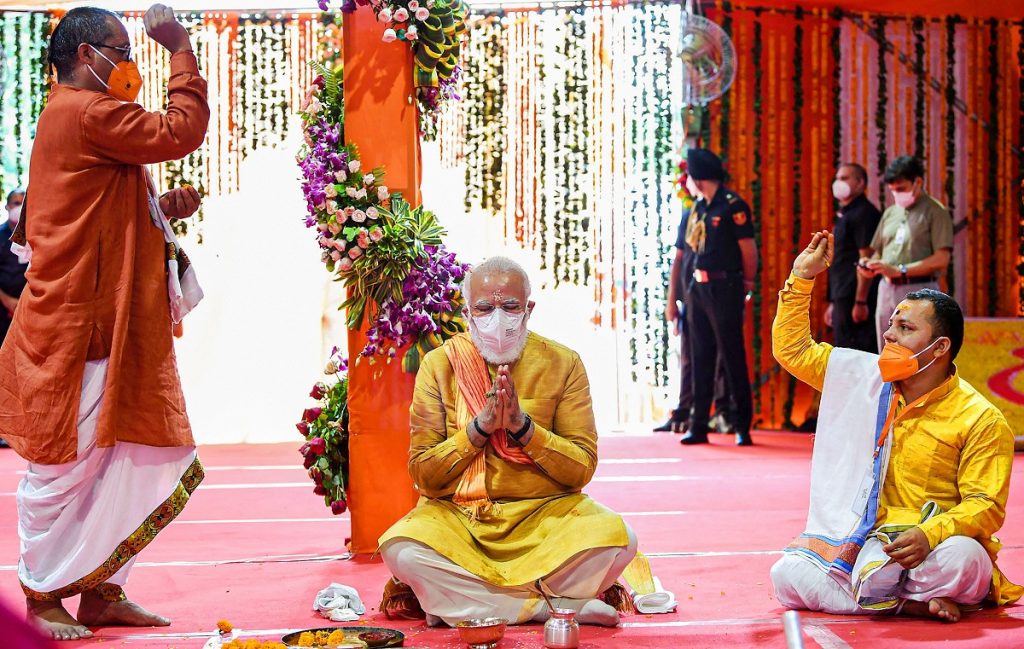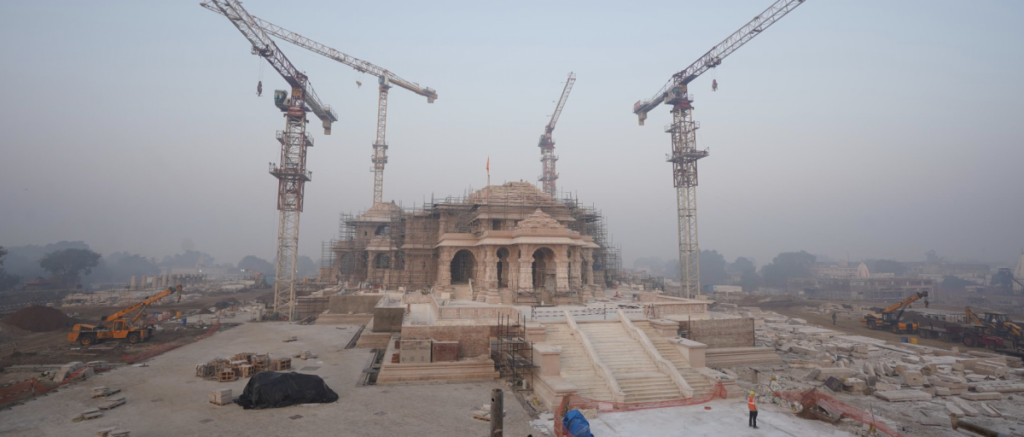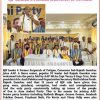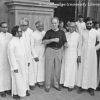Goa is abuzz with excitement as vintage bike and car owners, users, collectors and fans are decking […]

DELIRIUM OVER RAM MANDIR: A NATION CONSECRATED OR DESECRATED? By Mathew John
In the News, Jan 13 - Jan 19 2024 January 12, 2024PM Narendra Modi takes part in the bhoomi pujan for the construction of a Ram temple in Ayodhya, August 5, 2020.
By Mathew John
The collective hullaballoo over the consecration of the Ram temple under the aegis of the Modi government represents the triumph of religious fundamentalism over secularism.
Not quite midnight’s child but born less than two years after India gained Independence, one cannot help but reminisce about the time when we affirmed our common humanity despite our differences and strove with hope to build a “Sovereign Socialist Secular Democratic Republic committed to Justice, Equality and Liberty for the people.”
While respecting and treating the panoply of religions without fear or favour, the framers of our constitution clearly did not intend for the state to involve itself in promoting any form of religion. Instead, they advocated a secular humanism that propagated a separation of religious activities and state functions. It has been a rocky journey with many misses and some hits, but today, the noble aspirations expressed in the preamble to the constitution seem like an absurd fantasy, a cruel joke.
This is no longer the country that our founding fathers fought and died for. The cosmopolitan spirit of brotherhood, tolerance and inclusion has been all but snuffed out by the creeping majoritarianism and perverse hyper-nationalism sweeping across the land. Religion is now deployed as a dubious expedient for gaining worldly control.
I remember Arun Shourie, arguably the most intrepid editor in former Prime Minister Indira Gandhi’s time, lambasting her conduct during her election campaign in Chikmagalur in 1978, pointing out her hypocrisy in “preaching secularism in between visits to every temple in the vicinity.” Religiosity in the public square was then frowned upon. Today, religion has not only become integral to politics, but the flaunting of religious fervour has become de rigueur for any politician who wants to ‘make it’.
To reductively brush off the buzz around the January 22 Ram Mandir inauguration as a gimmick for electoral purposes would be a complete misreading of a grim situation. The planned mass mobilisation of the majority community – the running of 1,000 trains to Ayodhya from various parts of the country, the ruling party’s arrangements to host 50,000 pilgrims every day, the invitation to 150 disparate groups cutting across caste lines and 4,000 holy men for the consecration ceremony, the installation of 5 lakh LED screens in temples, the prime minster’s injunction to celebrate January 22 as Diwali by lighting diyas at home – is nothing less than a carefully calibrated campaign of consolidation of Hindu society and a call to arms for furthering the “kamandal” project whose ultimate mission is the reclaiming of temples, implementation of the uniform civil code, ban on cow slaughter, halal meat, the hijab and a lot more.
The clear subterranean text is not difficult to guess, which is the “othering” of minorities and Muslims in particular. At its core, the mobilisation of the masses (only Hindu) for the Ram temple consecration is clearly intended to whip up a communal consensus on a Hindu Rashtra.
There are disturbing markers that capture the zeitgeist of our times – of a majoritarian State that is on a mission to reduce the minorities to second-class citizens. The Ram temple is not quite done but there are already menacing rumblings around the Gyanvapi masjid in Varanasi and the Shahi Idgah mosque in Mathura. We know by now that the slogan, “Yeh to sirf jhanki hai, Kashi-Mathura baaki hai (This is just a trailer, Kashi and Mathura are still pending)”, is no idle boast!
Our home minister, who says it like it is, has announced to the world that the Citizens Amendment Act (CAA), which brazenly discriminates against Muslims, will soon be implemented. As ominous is his calculated statement that Modi had cured Gujarat of riots by teaching rioters (read Muslims) a lesson in 2002. By obliquely suggesting that Modi had presided over the nightmarish events in the aftermath of the Godhra train burning, the home minister is thumbing a nose at the Supreme Court verdict exonerating Modi of any involvement in the genocide that followed in the wake of Godhra. Modi’s closest aide has made this provocative claim because he knows that for millions of Bharatiya Janata Party (BJP) followers, the undying faith in Modi stems primarily from their fond belief that he is the only leader who can deal effectively with the “Muslim menace.”
Of a piece with the planned, all-out offensive against Muslims is the obnoxious, dastardly attack on the Muslim community by BJP MP Ramesh Bidhuri from within the sacred precincts of Parliament even as senior BJP members beamed with delight. No action was taken against him. In a hate-filled environment that thrives on Muslim bashing, this hate-monger could well be the new poster boy of the BJP like Yogi Adityanath and Sadhvi Pragya before him.
The present regime has smashed the flimsy secular facade that corralled the state from religion, which is now front and centre in the public arena and the ultimate arbiter of temporal power. The savage conduct of the trishul-brandishing bhakts in recent years under the benign gaze of the state, vindicates Italian philosopher Umberto Eco’s observation that ordinary people are never so completely and enthusiastically evil as when they act out of religious conviction. The collective delirium over the consecration of the Ram temple at Ayodhya under the aegis of the Modi government represents the emphatic triumph of religious fundamentalism over secularism, of Hindutva over Hinduism, of religiosity over religion, of exclusion over inclusion, of hate over brotherhood.
Ram must be distraught, if not enraged, at what is being done in his name. He is the epitome of justice, compassion, peace and non-violence. He personifies truthfulness, forgiveness, accountability and empathy with his subjects. From the Ramayana we know that Ram was the perfect son, the ideal husband and the quintessentially responsible ruler. As depicted in the Ramayana, Ram’s story in essence embodies the victory of righteousness over evil and the advent of Ram Rajya.

The greatest Indian and Hindu, Mahatma Gandhi who was deeply influenced by the Ramayana, in an expository piece that appeared in Young Indian in 1929, explained what Ram Rajya means: “By Ram Rajya, I do not mean Hindu Raj. I mean Ram Raj, the kingdom of God. For me Ram and Rahim are one and the same; I acknowledge no other God but the one God of truth and righteousness.” For the Mahatma, Ram Rajya meant equal citizenship – “equal rights to both prince and pauper.” Is it any surprise then that Gandhism is viewed as a mortal enemy of Hindutva? But by the looks of it, Hindutva is up and running and to hell with Gandhiji and secularism.
The grand consecration on January 22 is slated to be the greatest politico-religious event of our time and will be presided over by the high priest of Hindutva, the prime minister himself. But far from being the crowning glory of a great religion, the Ram Mandir, built on the ruins of a mosque vandalised by religious fanatics and now in the hands of the vandals and their mentors is, in truth, a symbol of the triumph of majoritarian nationalism. As an outlier who has watched with cold fear the march of Hindutva to the centre of our national life, the Ram temple symbolises the formal investiture of the Hindu Rashtra and the death of secular India. One wonders what our founding fathers would have thought of such a radical transmutation of the body politic. Their angst can best be expressed by invoking Mahatma’s last anguished cry: “Hey Ram!”
Mathew John is a former civil servant. The views are personal.
Courtesy: The Wire















